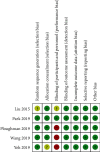Effects of Combined Cognitive and Exercise Interventions on Poststroke Cognitive Function: A Systematic Review and Meta-Analysis
- PMID: 34840972
- PMCID: PMC8612794
- DOI: 10.1155/2021/4558279
Effects of Combined Cognitive and Exercise Interventions on Poststroke Cognitive Function: A Systematic Review and Meta-Analysis
Abstract
Objective: We investigated combined cognitive and exercise interventions in the literature and summarized their effectiveness in improving poststroke cognitive impairment (PSCI). Data Sources. Electronic databases and trial registries were searched from their inception until July 2020. Study Selection. Trials were collected with the following study inclusion criteria: (1) patients over 18 years of age who were diagnosed with PSCI; (2) combined cognitive-exercise interventions, regardless of the order of the two types of interventions or whether they were administered simultaneously; (3) any control group studied at the same time that was deemed acceptable, including no intervention/routine care, delayed intervention, sham intervention, and passive training; (4) the use of any validated cognitive neuropsychological test to evaluate cognitive function; and (5) clinically administered random trials with controls. Data Extraction. Five randomized controlled trials met the inclusion criteria. Two reviewers independently assessed the eligibility of the full texts and methodological quality of the included studies using the Cochrane risk of bias tool. Inconsistent results were resolved by additional discussion or decided by a third examiner, if necessary. Data Analysis. Meta-analysis demonstrated that the combined interventions had a significant effect on executive function and working memory [Stroop test (time), standardized mean difference (SMD) = 0.42, 95% confidence interval (CI): 0.80-0.04, p = 0.02; Trail Making Test, SMD = 0.49, 95% CI: 0.82-0.16, p = 0.004; Forward Digit Span Test, SMD = 0.91, 95% CI: 0.54-1.29, p ≤ 0.001]. While it was impossible to conduct a meta-analysis of global cognitive function and other cognitive domains, individual experiments demonstrated that the combined interventions played a significant role in global cognition, reasoning ability, logical thinking, and visual-spatial memory function.
Conclusions: Our analyses demonstrated that the combined interventions had a significant effect on the improvement of PSCI, particularly in terms of executive function. However, the moderate risk of bias in the included trials and the small number of relevant studies indicated a need for more uniform diagnostic and evaluation criteria, and larger trials would provide stronger evidence to better understand the effectiveness of the combined interventions. This trial is registered with trial registration number INPLASY202160090.
Copyright © 2021 Ruifeng Sun et al.
Conflict of interest statement
The authors declare that they have no conflicts of interest.
Figures




Similar articles
-
Managing cognitive impairment following stroke: protocol for a systematic review of non-randomised controlled studies of psychological interventions.BMJ Open. 2018 Jan 10;8(1):e019001. doi: 10.1136/bmjopen-2017-019001. BMJ Open. 2018. PMID: 29326188 Free PMC article.
-
Rehabilitation of cognitive deficits poststroke: protocol for a systematic review and meta-analysis of randomised controlled trials of non-pharmacological interventions.BMJ Open. 2019 Nov 7;9(11):e031052. doi: 10.1136/bmjopen-2019-031052. BMJ Open. 2019. PMID: 31699730 Free PMC article.
-
Effects of exercise interventions for specific cognitive domains in old adults with mild cognitive impairment: A meta-analysis and subgroup analysis of randomized controlled trials.Medicine (Baltimore). 2020 Jul 31;99(31):e20105. doi: 10.1097/MD.0000000000020105. Medicine (Baltimore). 2020. PMID: 32756073 Free PMC article.
-
Effects of exercise, cognitive, and dual-task interventions on cognition in type 2 diabetes mellitus: A systematic review and meta-analysis.PLoS One. 2020 May 14;15(5):e0232958. doi: 10.1371/journal.pone.0232958. eCollection 2020. PLoS One. 2020. PMID: 32407347 Free PMC article.
-
Associations of Multidomain Interventions With Improvements in Cognition in Mild Cognitive Impairment: A Systematic Review and Meta-analysis.JAMA Netw Open. 2022 May 2;5(5):e226744. doi: 10.1001/jamanetworkopen.2022.6744. JAMA Netw Open. 2022. PMID: 35503222 Free PMC article.
Cited by
-
Dance after stroke improves motor recovery in the subacute phase: A randomized controlled trial.Heliyon. 2023 Nov 13;9(11):e22275. doi: 10.1016/j.heliyon.2023.e22275. eCollection 2023 Nov. Heliyon. 2023. PMID: 38053900 Free PMC article.
-
The influence of eight cognitive training regimes upon cognitive screening tool performance in post-stroke survivors: a network meta-analysis.Front Aging Neurosci. 2024 Jul 19;16:1374546. doi: 10.3389/fnagi.2024.1374546. eCollection 2024. Front Aging Neurosci. 2024. PMID: 39100748 Free PMC article.
-
Effects of dual-task training in patients with post-stroke cognitive impairment: A randomized controlled trial.Front Neurol. 2022 Oct 24;13:1027104. doi: 10.3389/fneur.2022.1027104. eCollection 2022. Front Neurol. 2022. PMID: 36353135 Free PMC article.
-
Move Your Body, Boost Your Brain: The Positive Impact of Physical Activity on Cognition across All Age Groups.Biomedicines. 2023 Jun 20;11(6):1765. doi: 10.3390/biomedicines11061765. Biomedicines. 2023. PMID: 37371860 Free PMC article. Review.
-
Enriched rehabilitation on brain functional connectivity in patients with post-stroke cognitive impairment.Front Neurol. 2025 Jan 7;15:1503737. doi: 10.3389/fneur.2024.1503737. eCollection 2024. Front Neurol. 2025. PMID: 39845930 Free PMC article.
References
Publication types
MeSH terms
LinkOut - more resources
Full Text Sources
Medical
Miscellaneous

